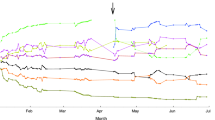Abstract
Group changing behavior of maleMacaca mulatta was studied over a six-year period at the rhesus monkey colony on two coastal islands at La Parguera, Puerto Rico. Males first left their natal group at a mean age of 47 months and became solitary for the first time at a mean age of 64 months; all had left their natal groups by seven years of age. Age, mating season, sex ratios of adult males and females in the social bands, and geographical barriers all had significant effects on the group shifting. Population size, rank of mother or being an orphan did not significantly affect the changing process. Two factors, age (size) and seniority in the group, were important in determining a male's rank in his new group.
Similar content being viewed by others
References
Boelkins, R. C. &A. P. Wilson, 1972. Intergroup social dynamics of the Cayo Santiago rhesus (Macaca mulatta) with special reference to changes in group membership by males.Primates 13: 125–140.
Kaufman, J. H., 1965. A three-year study of mating behavior in a free-ranging band of rhesus monkeys.Ecology 46: 500–512.
Koford, C. B., 1963. Rank of mothers and sons in bands of rhesus monkeys.Science 141: 356–357.
——, 1966. Population changes in rhesus monkeys: Cayo Santiago, 1960–1964.Tulane Stud. Zool. 13: 1–7.
Lindburg, D. G., 1969. Rhesus monkeys: Mating season mobility of adult males.Science 166: 1176–1178.
Marsden, H. M., 1968. Agonistic behavior of young rhesus monkeys after changes induced in social rank of their mothers.Anim. Behav. 16: 38–44.
Nishida, T., 1966. A sociological study of solitary male monkeys.Primates 7: 141–204.
Sade, D. S., 1967. Determinants of dominance in a group of free-ranging rhesus monkeys. Chpt. 7, In:Social Communication among Primates,S. Altmann (ed.) Univ. Chicago Press, Chicago.
Vandenbergh, J. G., 1967. The development of social structure in free-ranging rhesus monkeys.Behaviour 29: 179–194.
——, 1968. Seasonal breeding of free-ranging rhesus monkeys and related ecological factors.J. Reprod. Fertil. 15: 71–79.
Van Wagenen, G. &M. E. Simpson, 1954. Testicular development in therhesus monkey.Anat. Rec. 118: 231–251.
Vessey, S. H., 1971. Free-ranging rhesus monkeys: Behavior effects of removal, separation and reintroduction of group members.Behaviour 40: 216–227.
Author information
Authors and Affiliations
About this article
Cite this article
Drickamer, L.C., Vessey, S.H. Group changing in free-ranging male rhesus monkeys. Primates 14, 359–368 (1973). https://doi.org/10.1007/BF01731357
Received:
Accepted:
Issue Date:
DOI: https://doi.org/10.1007/BF01731357




